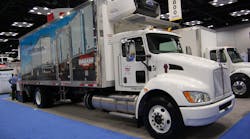Trailer maker Wabash National Corp. aims to acquire fellow Indiana-based manufacturer Supreme Industries, which makes truck bodies, in a $21 per share stock offer worth between $342 million and $364 million.
Founded in 1974, Supreme is the second largest U.S. manufacturer of truck bodies, with 2016 sales of $299 million, according to Wabash -- primarily building light- and medium-duty truck bodies at seven facilities throughout the U.S.
Dick Giromini, Wabash’s CEO, said in a statement that the deal would merge the two companies and beef up Wabash’s own truck body manufacturing operations, positioning it to capitalize on the $2 billion “final mile” logistics market that’s rapidly increasing due to e-commerce activity.
“We formally entered the final mile space in 2015 with the launch of our dry and refrigerated truck bodies, and we have been aggressively growing our presence and product offering over the past two years,” he explained. “This acquisition supports these efforts and accelerates our objective to transform our business into a more diversified industrial manufacturer.”
Giromini noted that acquiring Supreme provides Wabash with “significant growth and diversification benefits” in line with the company’s long-term strategic plan, including reduced dependence on dry van trailer demand, "reduced cyclicality" and new segments for growth.
Under the terms of the agreement and merger plan, Wabash formed an acquisition subsidiary – Redhawk Acquisition Corp. – that will commence a tender offer to purchase all outstanding shares of Supreme for $21 per share.
The deal is expected to be wrapped up no later than the fourth quarter of this year.
Following the completion of the tender offer, Wabash expects to consummate a merger of Redhawk Acquisition Corp. and Supreme in which shares of Supreme that have not been purchased in the tender offer will be converted into the right to receive the same cash price per share as paid in the tender offer.
In all, Wabash expects the deal to deliver at least $20 million in annual “run-rate” cost synergies by 2021, with expected cost synergies primarily driven by corporate and procurement expenditures plus operational improvement savings.
Over time, Wabash said it expects to achieve “significant incremental revenue opportunities” via its acquisition and merger with Supreme that neither company could obtain on a standalone basis.
The Supreme acquisition is part of a larger “diversification” strategy on the part of Wabash that Giromini touched on in the company’s second quarter earnings call – a strategy aimed at “insulating” the company from the cyclical ups and downs in trailer demand.
“Certainly, there is increased focus [on acquisitions]; we've stated that in recent quarters that with the health of the company, the strength of the balance sheet really provides us an opportunity to increase the focus and effort in that arena,” he explained during the company’s earnings call in late July.
“We're taking more targeted approach; not simply waiting for opportunities to come across the transom,” Giromini added. “We're extremely excited about … the final-mile space. It's an area that we have invested in and continue to invest in organically here. And we continue to look at opportunities in that space to grow through strategic acquisition.”
And the money is apparently there to do it. On a consolidated basis, Wabash booked revenue of $436 million in the second quarter this year, which is a decrease of $36 million or 8% compared to the second quarter of 2016, with new trailer shipments reaching 14,150 units.
In terms of operating results, Wabash reported consolidated gross profit in the second quarter of $57.7 million or 15.5% of sales. Gross profit was down $23.4 million year-over-year and up $8.3 million sequentially, the company added, while it generated operating income and margin of $38.7 million and 8.9%, respectively.



